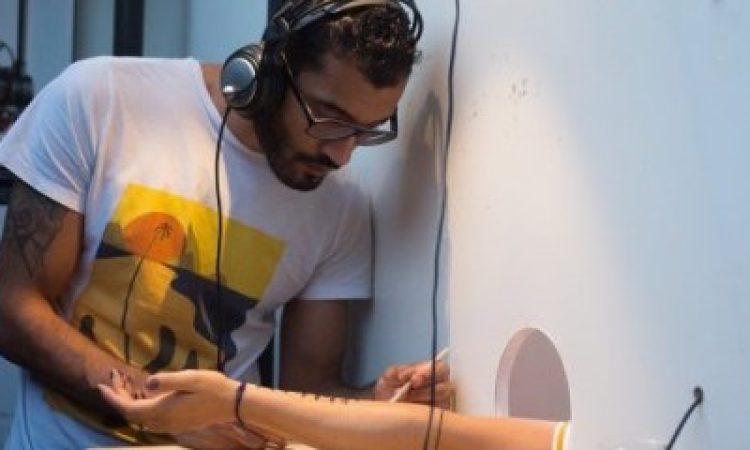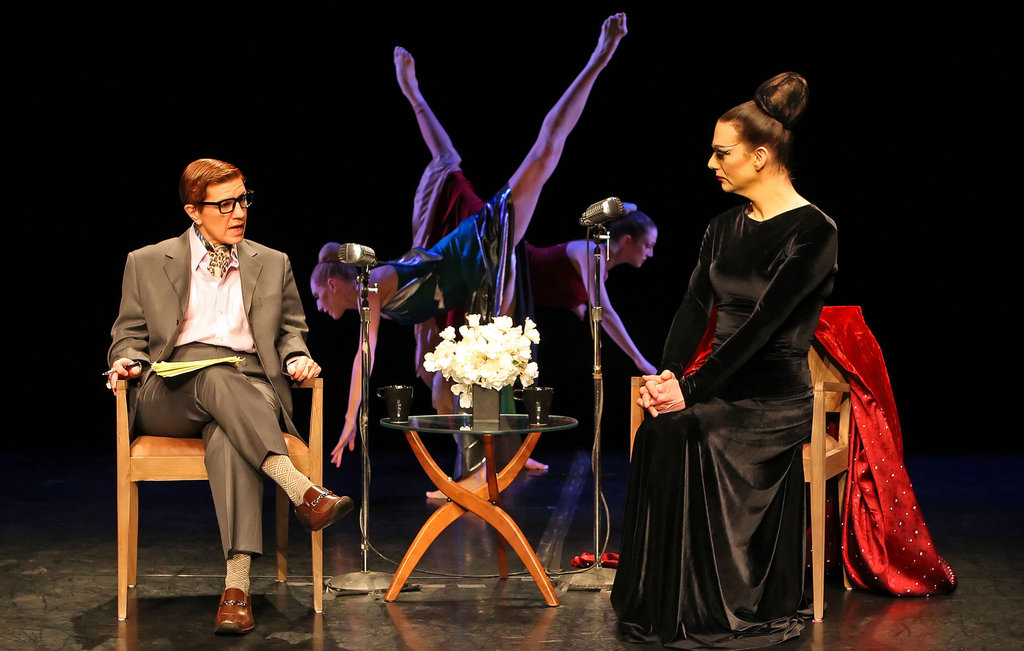In a quest to reach new audiences for performing arts in Philadelphia, Theatre Philadelphia and thINKingDANCE are joining forces and exploring how dance writing and discourse can provide new perspectives on theatre. Beginning May 2018, tD writers will be lending their varied backgrounds, interests, and approaches to criticism to professional works of theatre in Philadelphia. Let us know what you think in the comments!
Bryn Mawr College and FringeArts collaborate in presenting, ear-whispered, five works by Tania El Khoury, and several related talks including a conversation between El Khoury and local artist, Pepón Osorio, and a lecture by Noura Erakat, “Understanding the Question of Palestine as an Anti-Racist Struggle.” The performances and installations included in ear-whispered all deal with the experiences of refugees and martyrs and implicate audiences in their stories. El Khoury’s works involve all the senses, evoking powerful associations and emotional states in the viewer-participants.
As Far as My Fingertips Take Me
Basel Zaraa––a Palestinian refugee whose grandparents fled Palestine during the Nakba in 1948, and who grew up as a refugee in Yarmouk refugee camp in Syria––gently opens my palm and draws a tiny boat, with a grey splash of water beneath, tethered to my longest finger by a thin black line. Sounds of the sea play on headphones as he draws. He blackens my fingertips. According to the Dublin Regulation, the first EU Member State that an asylum-seeker enters must capture their fingerprints and consider their asylum claim, regardless of the asylum-seeker’s destination.
Zaraa’s music plays, and I read the English translation from a piece of paper on my lap: “Then it’s just your luck with the sea. In short, you either beat it, or it beats you.” I see the name “Emily” tattooed on his wrist as his hand whisks by the small aperture through which we are interacting. I only see his arms. He draws a line around the circumference of my forearm as a boundary and rows of tiny people walking with bags toward the border where they will likely be detained.
Stories of Refuge
Looping documentaries of three Syrian refugees in Germany are projected onto white walls in a room containing three sets of bunk beds resembling those found in detention centers. The audience is invited to lie on the beds. The videos, which have been recorded by narrators with shaky hands, contain imagery that is extremely haphazard and disorienting. From a top bunk, I view a video below me through metal rails like prison bars.
Gardens Speak
We, ten audience members, are asked to remove our shoes, and to put on white, plastic coats that create a symphony of crinkles. Our guide, in all black, tells us to “make sure they’re all buttoned up.” We sit on benches opposite one another with a garden between us containing ten graves. We are each given a card with an Arabic name, and instructed to find the name on the person’s grave. We are told to dig and dig until we can hear their story retold through the eyes of their family, who have reconstructed their story.
Mustafa meets his love, Maha, online. She’s attracted to his profile photo, which is of Che Guevara. He describes watching the Arab Spring catch fire: “change was contagious.” He and Maha go to demonstrations against the Assad regime, holding hands. He describes his own death. Bullets puncture his heart, stomach, and liver while Maha watches, screaming. I am wearing my plastic white coat, but it is not buttoned up. There is dirt on my dress and between my toes as I dig them into the soil. There are grains and tears in my hair, and soil in my left ear that I am pressing into the earth to hear Mustafa’s story arising faintly from speakers underneath.
We are instructed to replace the soil, listen to music that reverberates from speakers above us, and write a letter to the person whose story we heard. I sit with the paper and pen I’ve been given until everyone else has left. I am unable to find any words for Mustafa and feel impotent in relation to his suffering.
Tell Me What I Can Do
A room is filled with scrolls of letters written by Gardens Speak audiences from all over the world to the ten martyrs whose graves we had listened to. Many letters state that the pain and devastation is inconceivable. The voice of Kanina Issa, a collaborator in the collecting of letters, emerges from a speaker near the window. She says that Syria is closer than we think.
Camp Pause
Four looping videos play simultaneously, but they eventually return to a unison view of the Lebanese shore from the Rashidieh refugee camp. In each video a narrator is seen sitting in front of the camera, vulnerable and unspeaking, while an audio recording of their voice is heard, as if we are listening to their thoughts. They speak about their relationships to the sea. A young girl loves to swim but resents the trash that adults allow to accumulate on the shore. An older woman resents the sea for making her ill. A man in his 30’s tells the interviewer (El Khoury) how each year there are fewer fish in his net. An older man––who lost one arm when Israeli soldiers shot him 30 times until it fell off––loves to sit and watch the water for hours.
In spite of the numerous mentions of historical events––such as the 1930’s when the camp was inhabited by Armenians, and the 70’s and 80’s during the Lebanese civil war, and attacks from Israel––there is no mention of the 1948 Nakba, which is a conspicuous omission, and leaves me wondering why the subjects in these films do not discuss the very reason why they have spent the majority (or all) of their lives as refugees.
Each video contains similar images and stories, which thread the piece together: children on swings, narrow alleys, trash, motorcycles, the sea, boys with toy guns, graves, historical descriptions of how the tents turned into concrete homes, grievances about how the Lebanese authorities do not readily grant building permits, nor allow building materials to pass through the one entrance to the camp. This single access point, which is guarded by the Lebanese military, effectively makes their home an open-air prison. While appearing to be an open, free space for recreation and contemplation, the sea is also a border.
To join the conversation, follow thINKingDANCE and Theatre Philadelphia online and on social media to read, share, and comment.
ear-whispered: works by Tania El Khoury, various locations presented by Bryn Mawr College and Fringearts, September 6-28.






